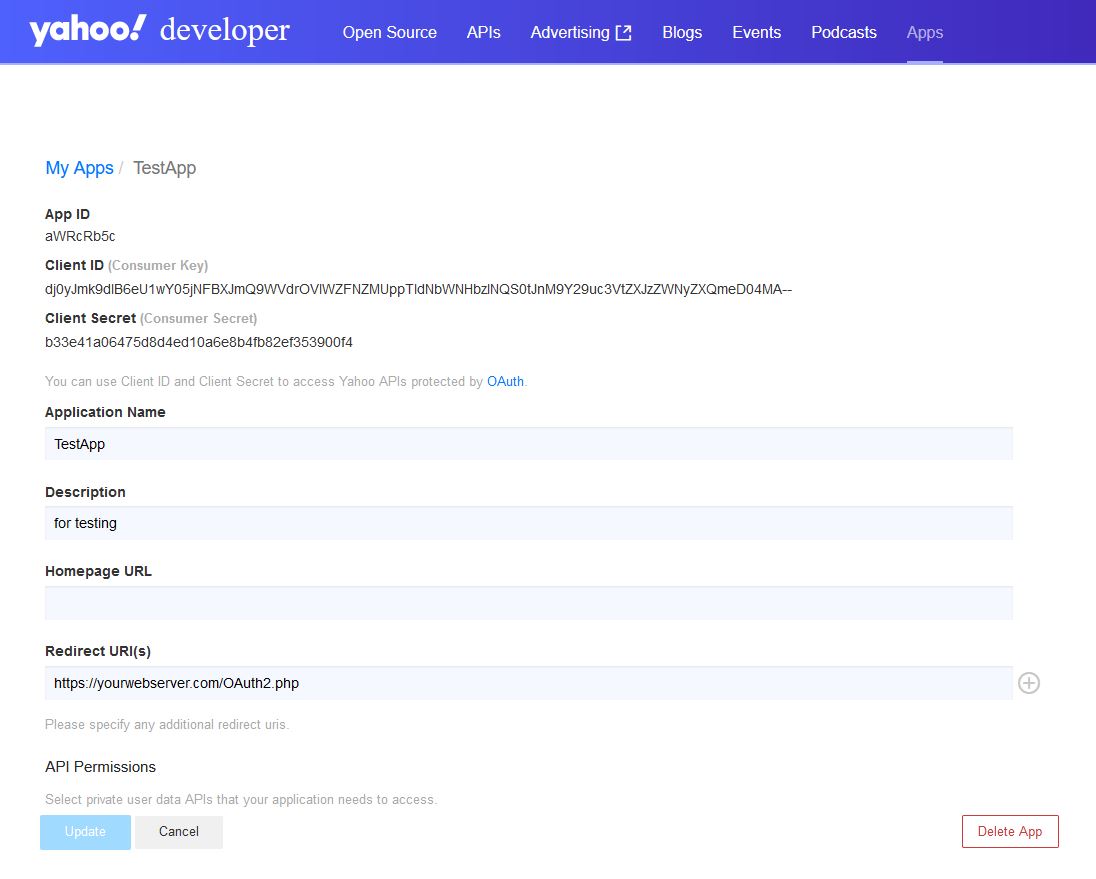|
|
(Ruby) Yahoo Mail OAuth2 Access Token for Desktop App
Demonstrates how to get a Yahoo Email OAuth2 access token from a desktop application or script.
Note: This example requires Chilkat v10.1.2 or greater. For more information, see https://developer.yahoo.com/oauth2/guide/
require 'chilkat'
# First, you must define your app in Yahoo Developer (https://developer.yahoo.com/apps/) like this:
#  # This example requires the Chilkat API to have been previously unlocked.
# See Global Unlock Sample for sample code.
oauth2 = Chilkat::CkOAuth2.new()
# Your applicaton must use your own public web server as an intermediate
# to receive and forward the redirect to localhost.
# See Using Your Web Server as an Intermediary for OAuth2 Redirect to localhost
oauth2.put_AppCallbackUrl("https://yourwebserver.com/oauth_redirect")
oauth2.put_ListenPort(3017)
oauth2.put_AuthorizationEndpoint("https://api.login.yahoo.com/oauth2/request_auth")
oauth2.put_TokenEndpoint("https://api.login.yahoo.com/oauth2/get_token")
# Replace these with actual values.
oauth2.put_ClientId("CLIENT_ID")
oauth2.put_ClientSecret("CLIENT_SECRET")
# Do not send the "scope" query param for Yahoo OAuth2.
oauth2.put_UncommonOptions("NO_OAUTH2_SCOPE")
# Begin the OAuth2 Authorization code flow. This returns a URL that should be loaded in a browser.
url = oauth2.startAuth()
if (oauth2.get_LastMethodSuccess() != true)
print oauth2.lastErrorText() + "\n";
exit
end
print "url = " + url + "\n";
# Launch the default browser on the system and navigate to the url.
# The LaunchBrowser method was added in Chilkat v10.1.2.
success = oauth2.LaunchBrowser(url)
if (success == false)
print oauth2.lastErrorText() + "\n";
exit
end
# Wait for the user to approve or deny authorization in the browser.
numMsWaited = 0
while (numMsWaited < 90000) and (oauth2.get_AuthFlowState() < 3)
oauth2.SleepMs(100)
numMsWaited = numMsWaited + 100
end
# If the browser does not respond within the specified time, AuthFlowState will be:
#
# 1: Waiting for Redirect - The OAuth2 background thread is waiting for the browser's redirect request.
# 2: Waiting for Final Response - The thread is awaiting the final access token response.
# In either case, cancel the background task initiated by StartAuth.
if (oauth2.get_AuthFlowState() < 3)
oauth2.Cancel()
print "No response from the browser!" + "\n";
exit
end
# Check AuthFlowState to determine if authorization was granted, denied, or failed:
#
# 3: Success - OAuth2 flow completed, the background thread exited, and the successful response is in AccessTokenResponse.
# 4: Access Denied - OAuth2 flow completed, the background thread exited, and the error response is in AccessTokenResponse.
# 5: Failure - OAuth2 flow failed before completion, the background thread exited, and error details are in FailureInfo.
if (oauth2.get_AuthFlowState() == 5)
print "OAuth2 failed to complete." + "\n";
print oauth2.failureInfo() + "\n";
exit
end
if (oauth2.get_AuthFlowState() == 4)
print "OAuth2 authorization was denied." + "\n";
print oauth2.accessTokenResponse() + "\n";
exit
end
if (oauth2.get_AuthFlowState() != 3)
print "Unexpected AuthFlowState:" + oauth2.get_AuthFlowState().to_s() + "\n";
exit
end
# Save the full JSON access token response to a file.
sbJson = Chilkat::CkStringBuilder.new()
sbJson.Append(oauth2.accessTokenResponse())
sbJson.WriteFile("qa_data/tokens/yahooMail.json","utf-8",false)
# The saved JSON response looks like this:
# {
# "access_token": "kCVQdnOdul...LHucA--",
# "refresh_token": "AIenVXETSo0jklFBVkPS8vVm8E.Ej9ToRG.xDbDYmZ65WIs5t6CZhDrD",
# "expires_in": 3600,
# "token_type": "bearer",
# "xoauth_yahoo_guid": "HGDQCVF5JB4YDOWHITQJFBHCWA"
# }
print "OAuth2 authorization granted!" + "\n";
print "Access Token: " + oauth2.accessToken() + "\n";
# This example requires the Chilkat API to have been previously unlocked.
# See Global Unlock Sample for sample code.
oauth2 = Chilkat::CkOAuth2.new()
# Your applicaton must use your own public web server as an intermediate
# to receive and forward the redirect to localhost.
# See Using Your Web Server as an Intermediary for OAuth2 Redirect to localhost
oauth2.put_AppCallbackUrl("https://yourwebserver.com/oauth_redirect")
oauth2.put_ListenPort(3017)
oauth2.put_AuthorizationEndpoint("https://api.login.yahoo.com/oauth2/request_auth")
oauth2.put_TokenEndpoint("https://api.login.yahoo.com/oauth2/get_token")
# Replace these with actual values.
oauth2.put_ClientId("CLIENT_ID")
oauth2.put_ClientSecret("CLIENT_SECRET")
# Do not send the "scope" query param for Yahoo OAuth2.
oauth2.put_UncommonOptions("NO_OAUTH2_SCOPE")
# Begin the OAuth2 Authorization code flow. This returns a URL that should be loaded in a browser.
url = oauth2.startAuth()
if (oauth2.get_LastMethodSuccess() != true)
print oauth2.lastErrorText() + "\n";
exit
end
print "url = " + url + "\n";
# Launch the default browser on the system and navigate to the url.
# The LaunchBrowser method was added in Chilkat v10.1.2.
success = oauth2.LaunchBrowser(url)
if (success == false)
print oauth2.lastErrorText() + "\n";
exit
end
# Wait for the user to approve or deny authorization in the browser.
numMsWaited = 0
while (numMsWaited < 90000) and (oauth2.get_AuthFlowState() < 3)
oauth2.SleepMs(100)
numMsWaited = numMsWaited + 100
end
# If the browser does not respond within the specified time, AuthFlowState will be:
#
# 1: Waiting for Redirect - The OAuth2 background thread is waiting for the browser's redirect request.
# 2: Waiting for Final Response - The thread is awaiting the final access token response.
# In either case, cancel the background task initiated by StartAuth.
if (oauth2.get_AuthFlowState() < 3)
oauth2.Cancel()
print "No response from the browser!" + "\n";
exit
end
# Check AuthFlowState to determine if authorization was granted, denied, or failed:
#
# 3: Success - OAuth2 flow completed, the background thread exited, and the successful response is in AccessTokenResponse.
# 4: Access Denied - OAuth2 flow completed, the background thread exited, and the error response is in AccessTokenResponse.
# 5: Failure - OAuth2 flow failed before completion, the background thread exited, and error details are in FailureInfo.
if (oauth2.get_AuthFlowState() == 5)
print "OAuth2 failed to complete." + "\n";
print oauth2.failureInfo() + "\n";
exit
end
if (oauth2.get_AuthFlowState() == 4)
print "OAuth2 authorization was denied." + "\n";
print oauth2.accessTokenResponse() + "\n";
exit
end
if (oauth2.get_AuthFlowState() != 3)
print "Unexpected AuthFlowState:" + oauth2.get_AuthFlowState().to_s() + "\n";
exit
end
# Save the full JSON access token response to a file.
sbJson = Chilkat::CkStringBuilder.new()
sbJson.Append(oauth2.accessTokenResponse())
sbJson.WriteFile("qa_data/tokens/yahooMail.json","utf-8",false)
# The saved JSON response looks like this:
# {
# "access_token": "kCVQdnOdul...LHucA--",
# "refresh_token": "AIenVXETSo0jklFBVkPS8vVm8E.Ej9ToRG.xDbDYmZ65WIs5t6CZhDrD",
# "expires_in": 3600,
# "token_type": "bearer",
# "xoauth_yahoo_guid": "HGDQCVF5JB4YDOWHITQJFBHCWA"
# }
print "OAuth2 authorization granted!" + "\n";
print "Access Token: " + oauth2.accessToken() + "\n";
|

